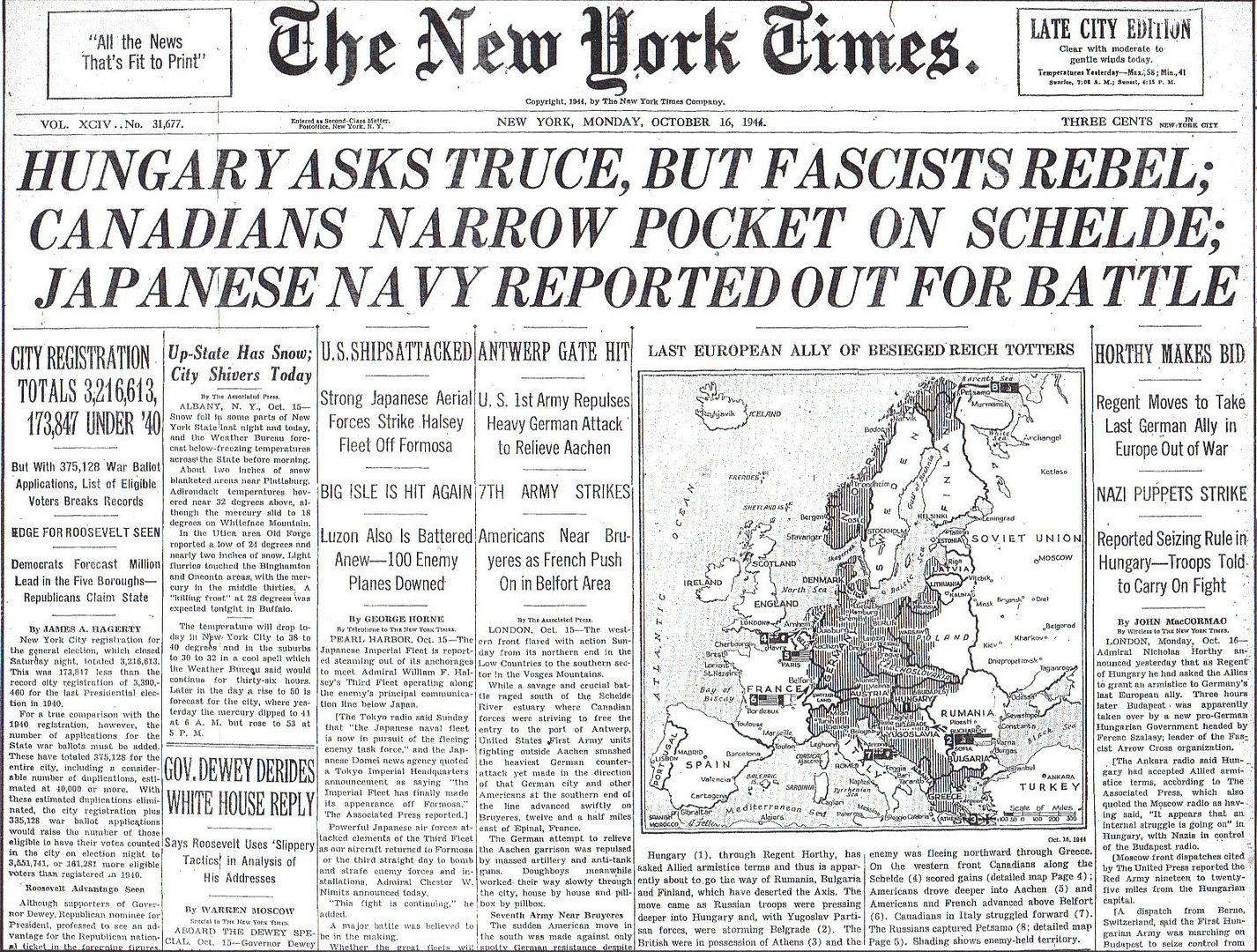
Posted on 10/16/2014 4:18:42 AM PDT by Homer_J_Simpson

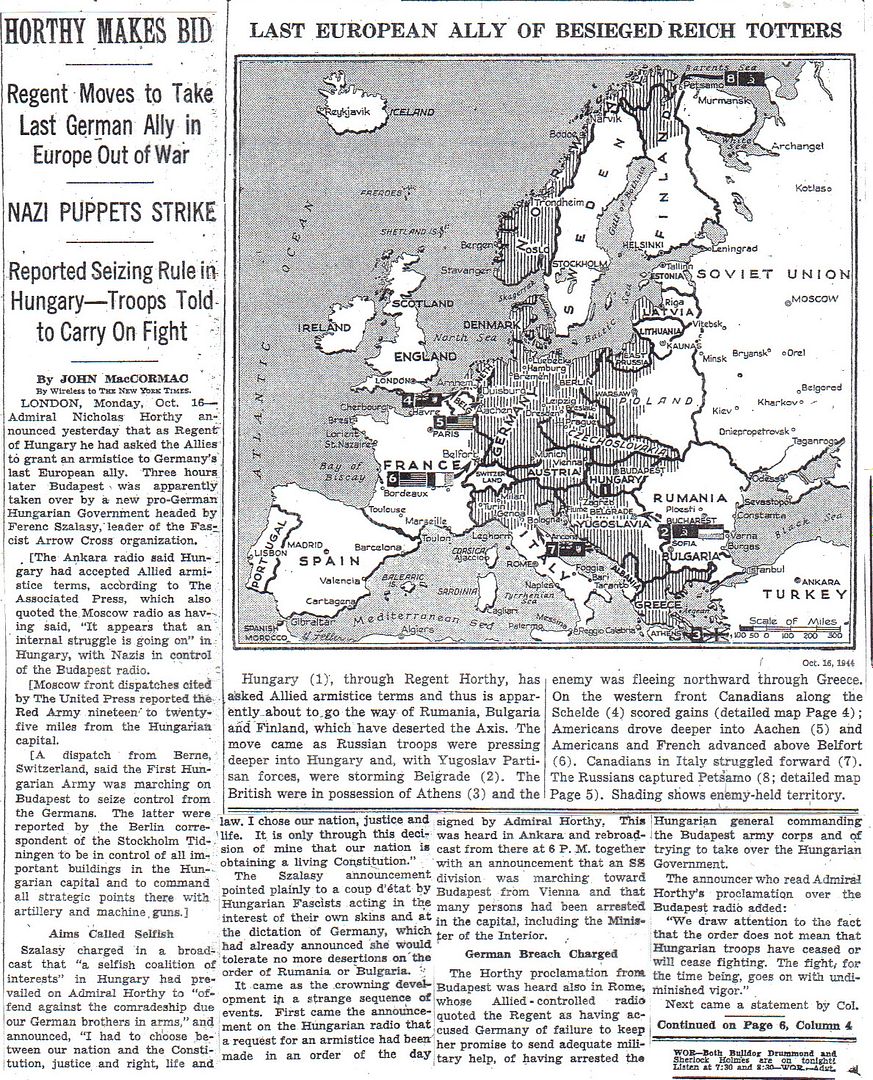
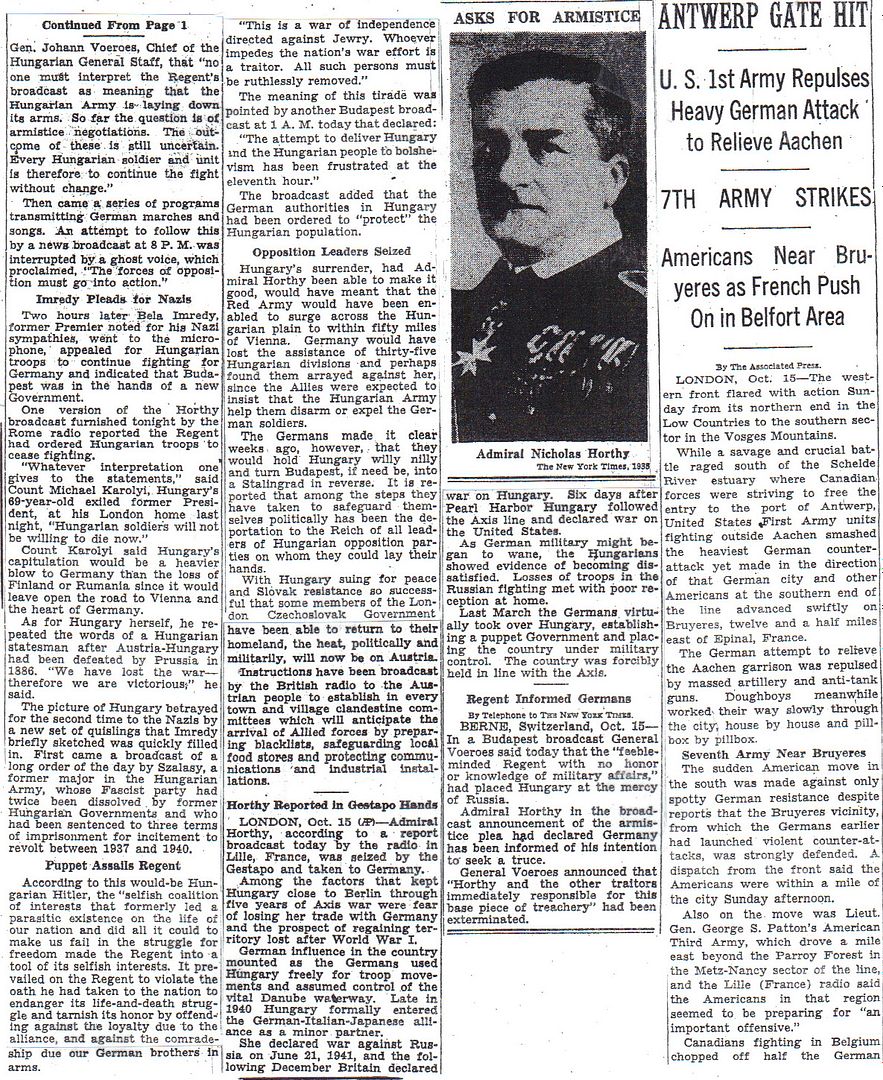
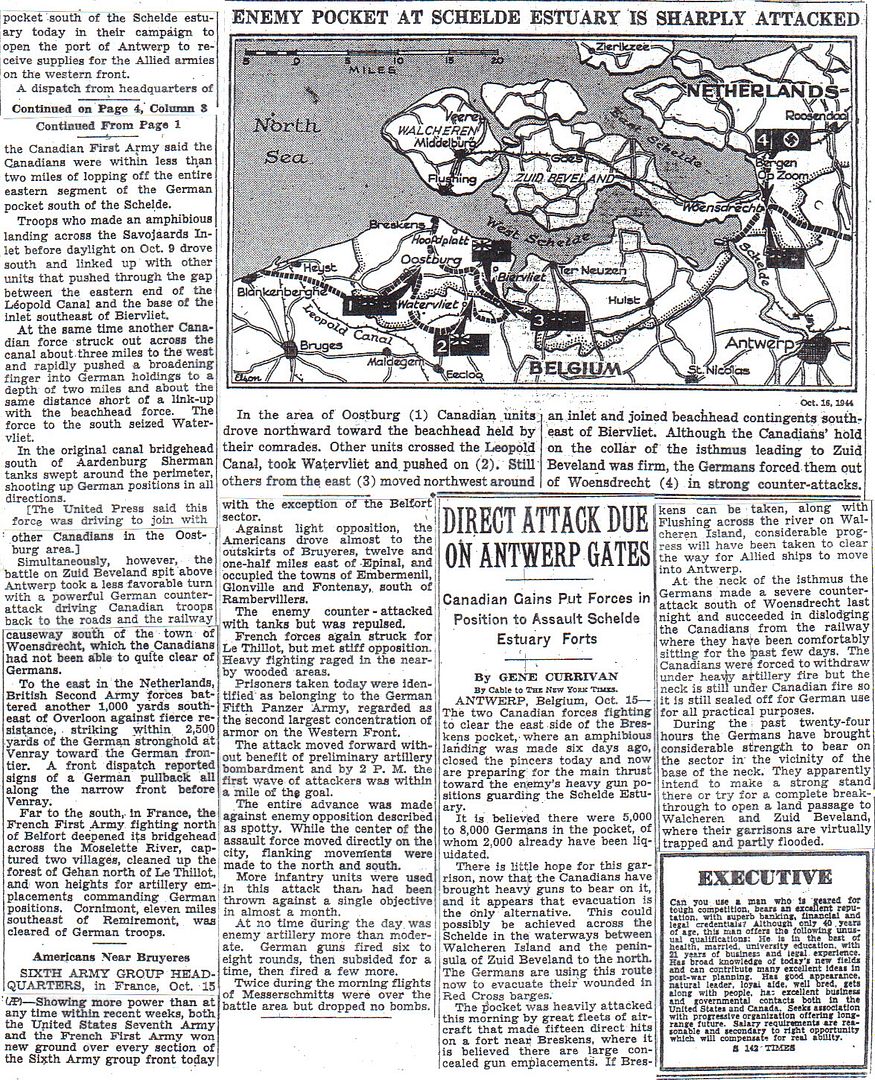
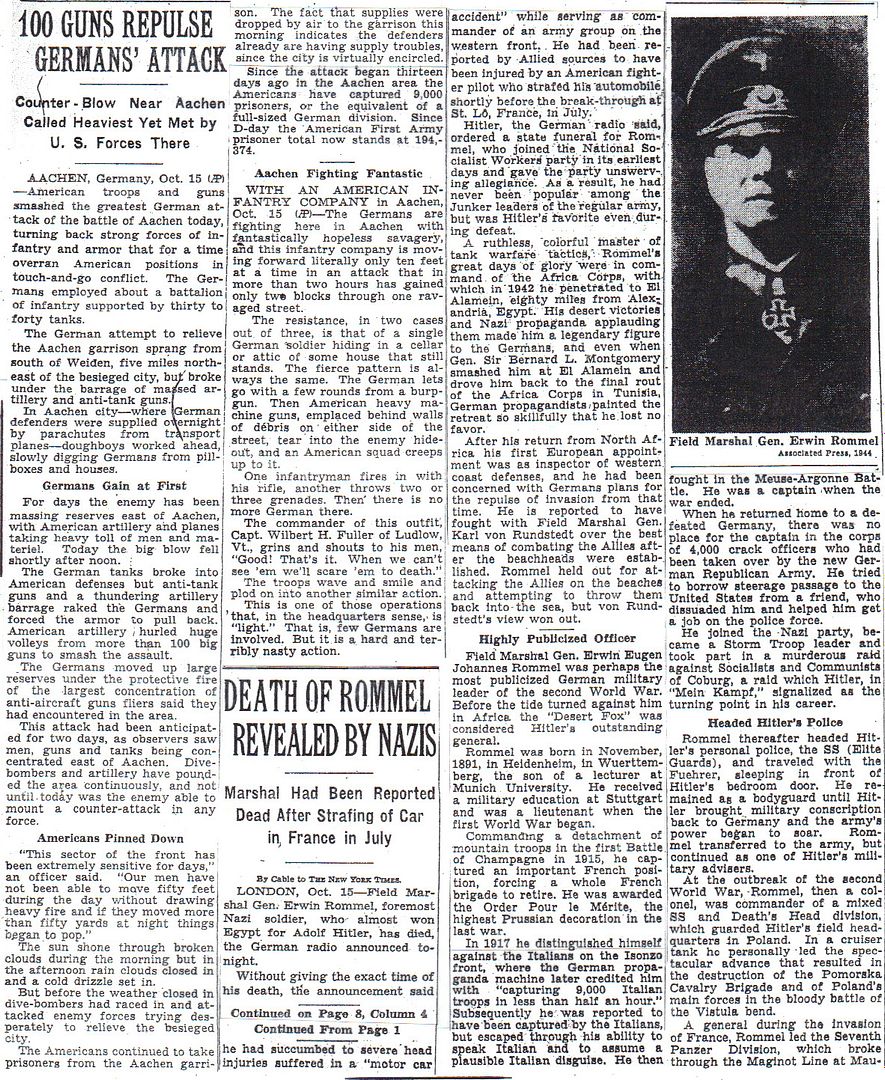
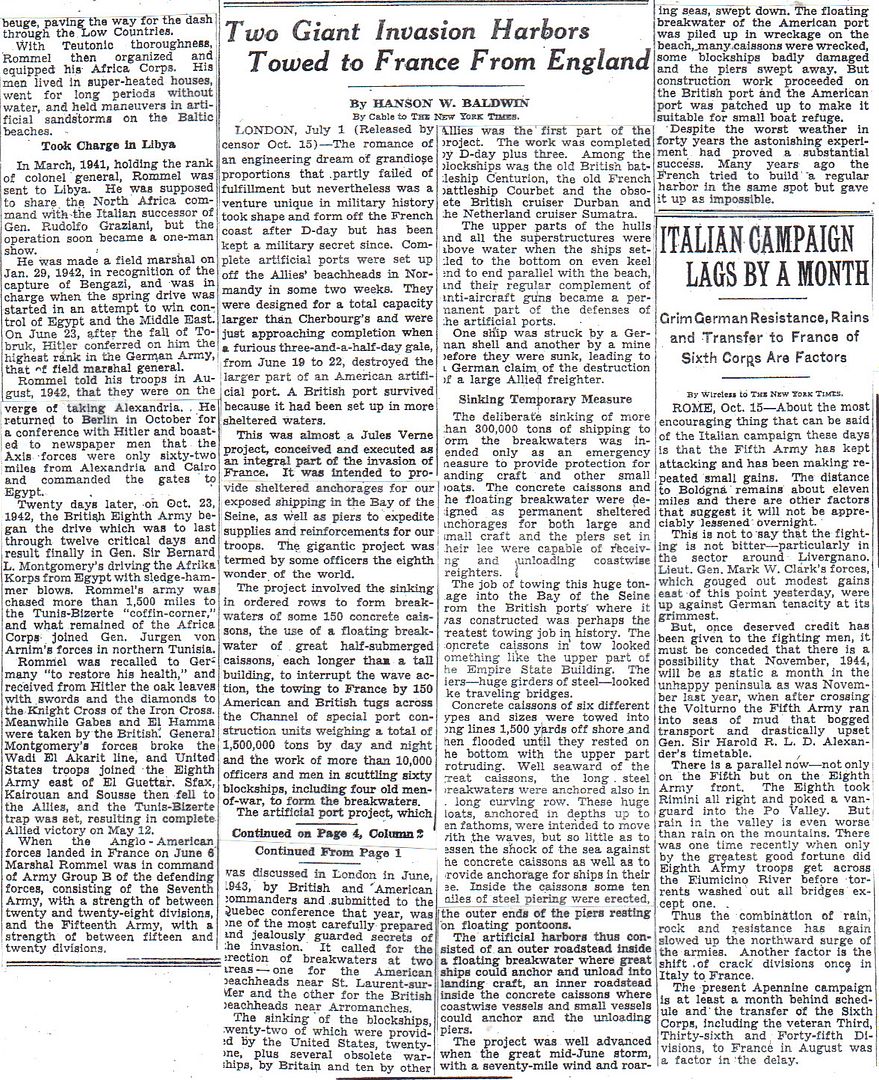
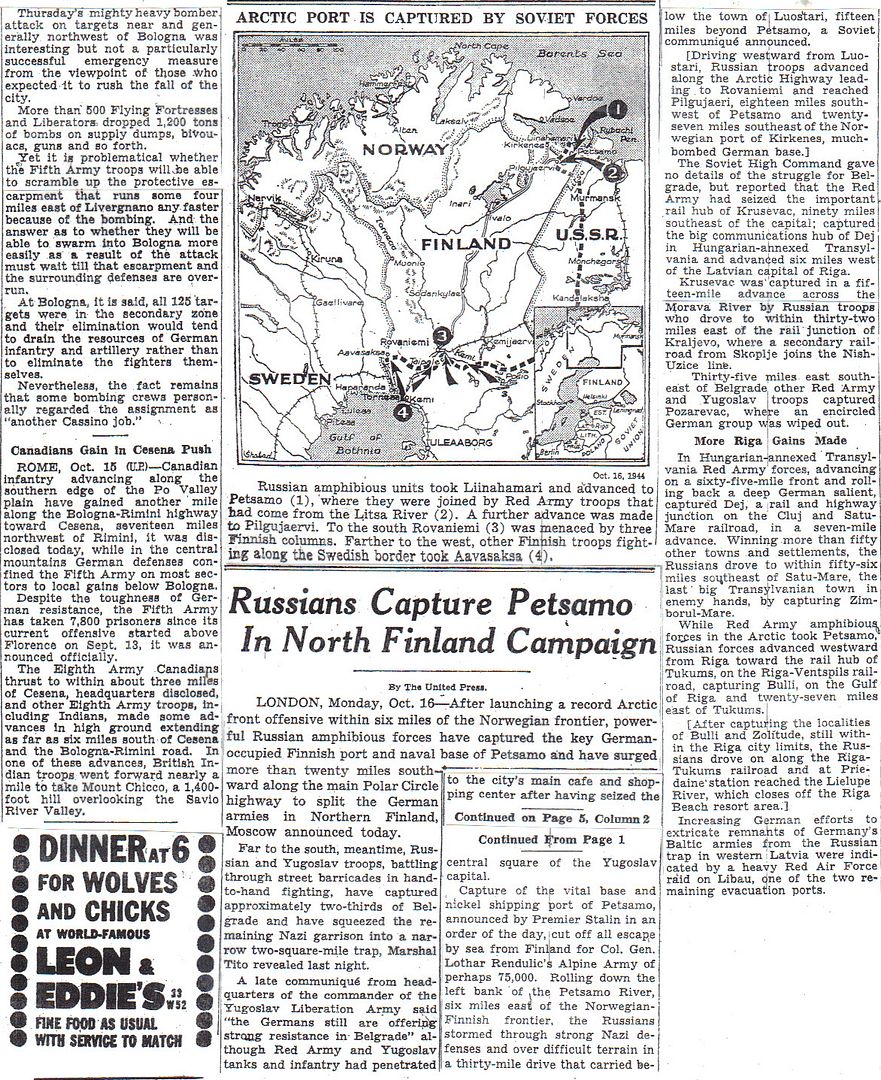
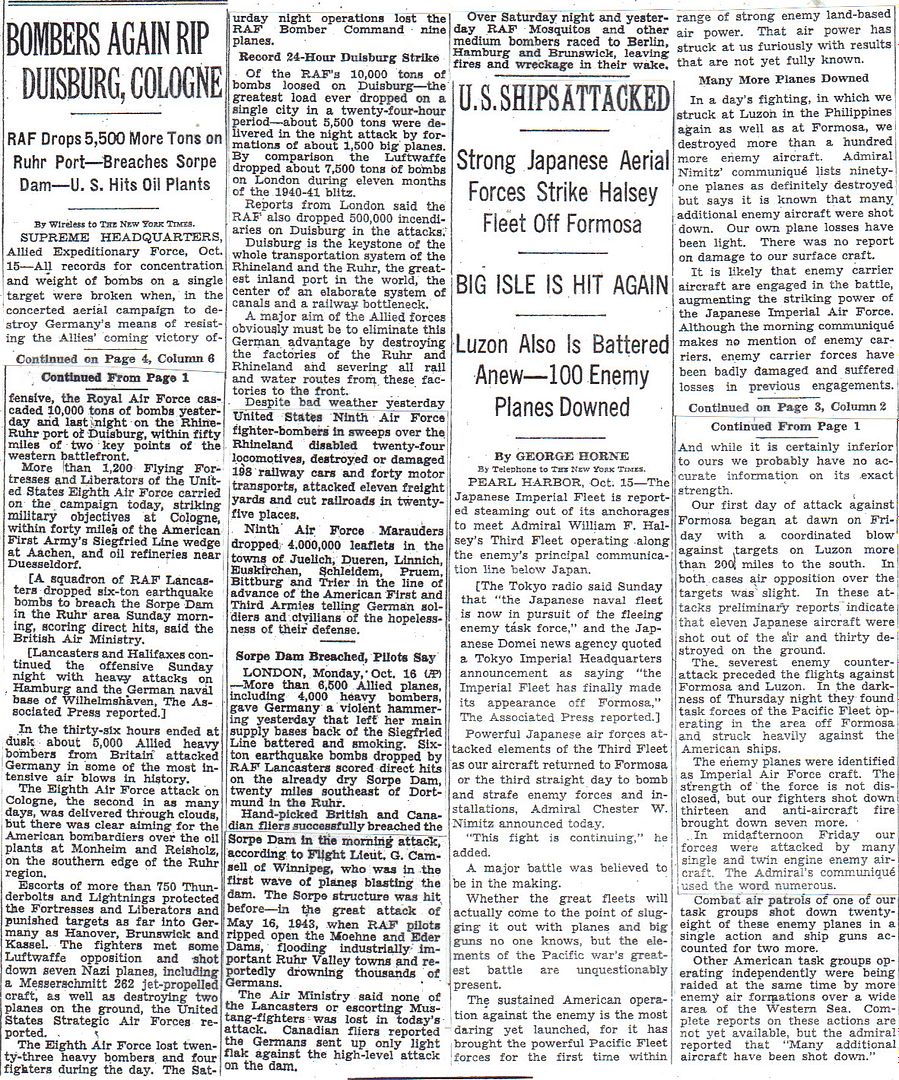
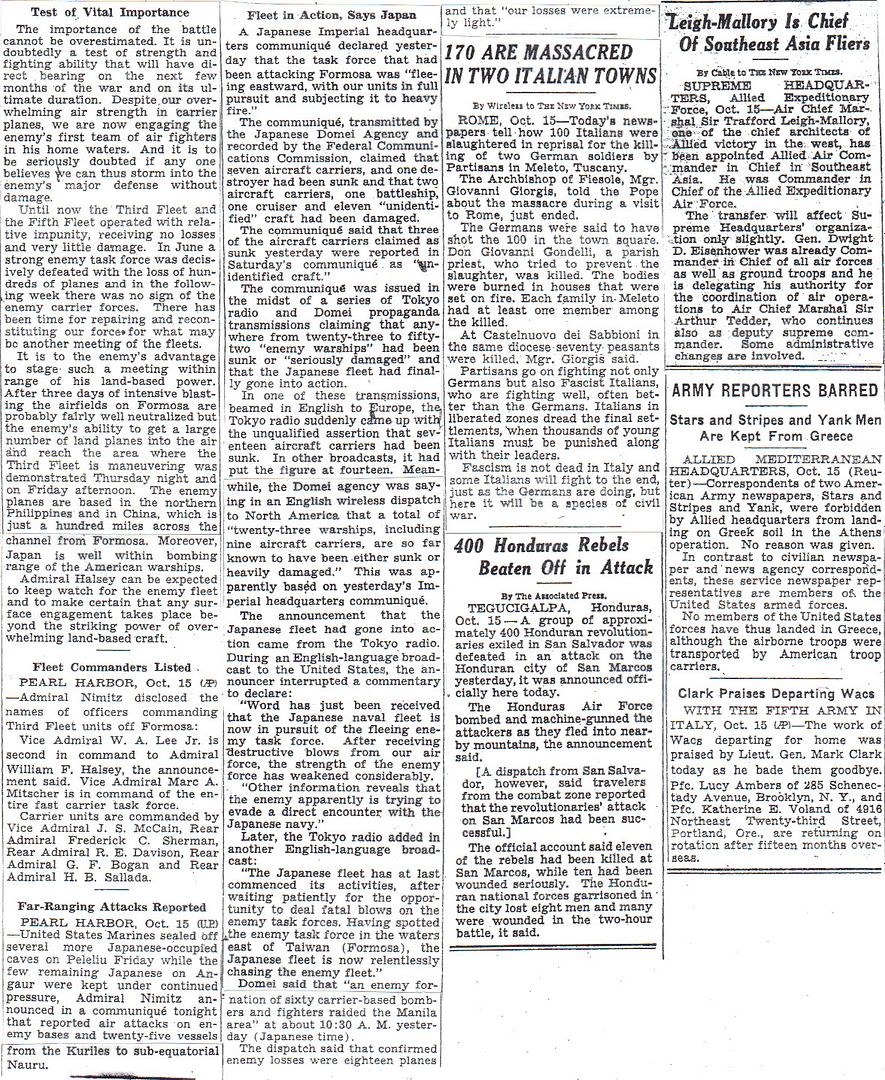
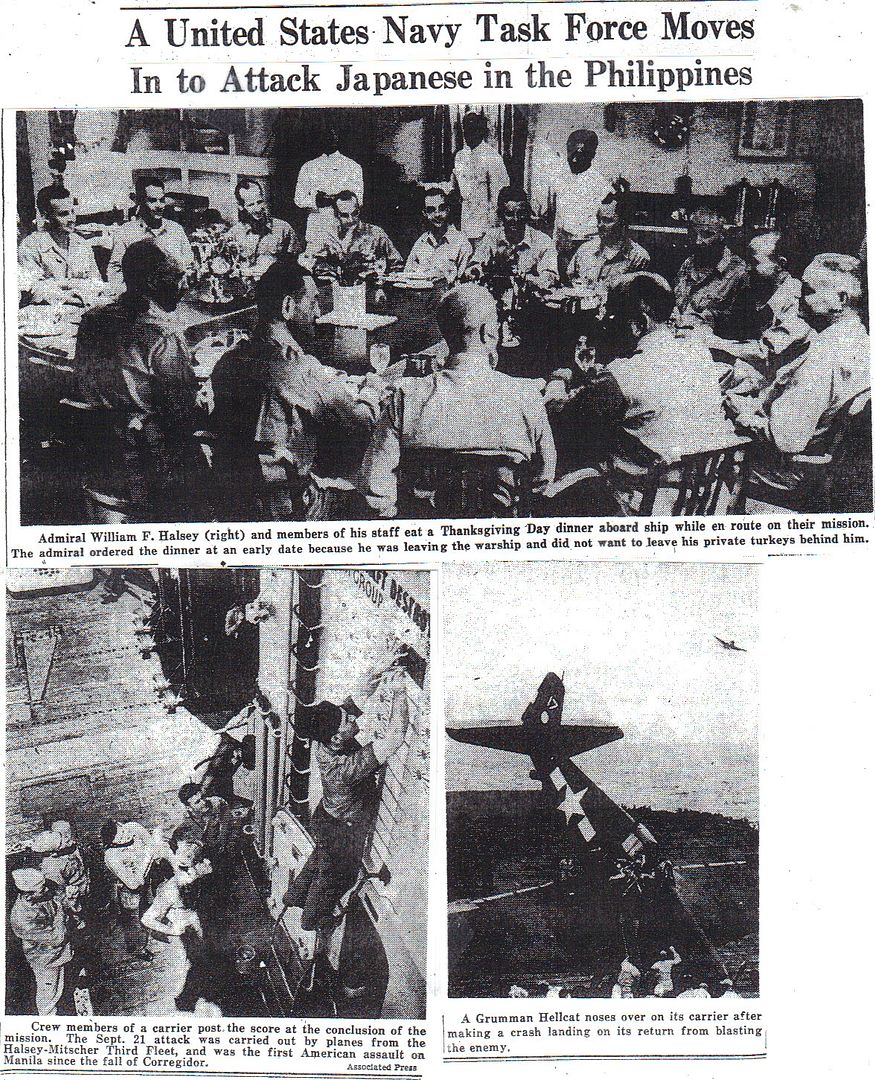






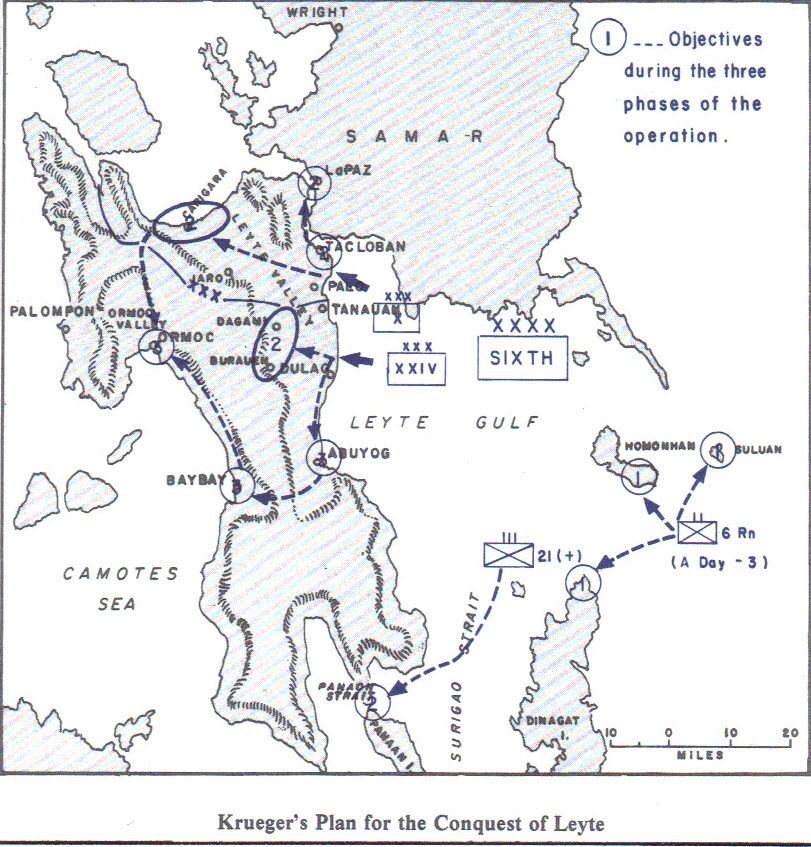
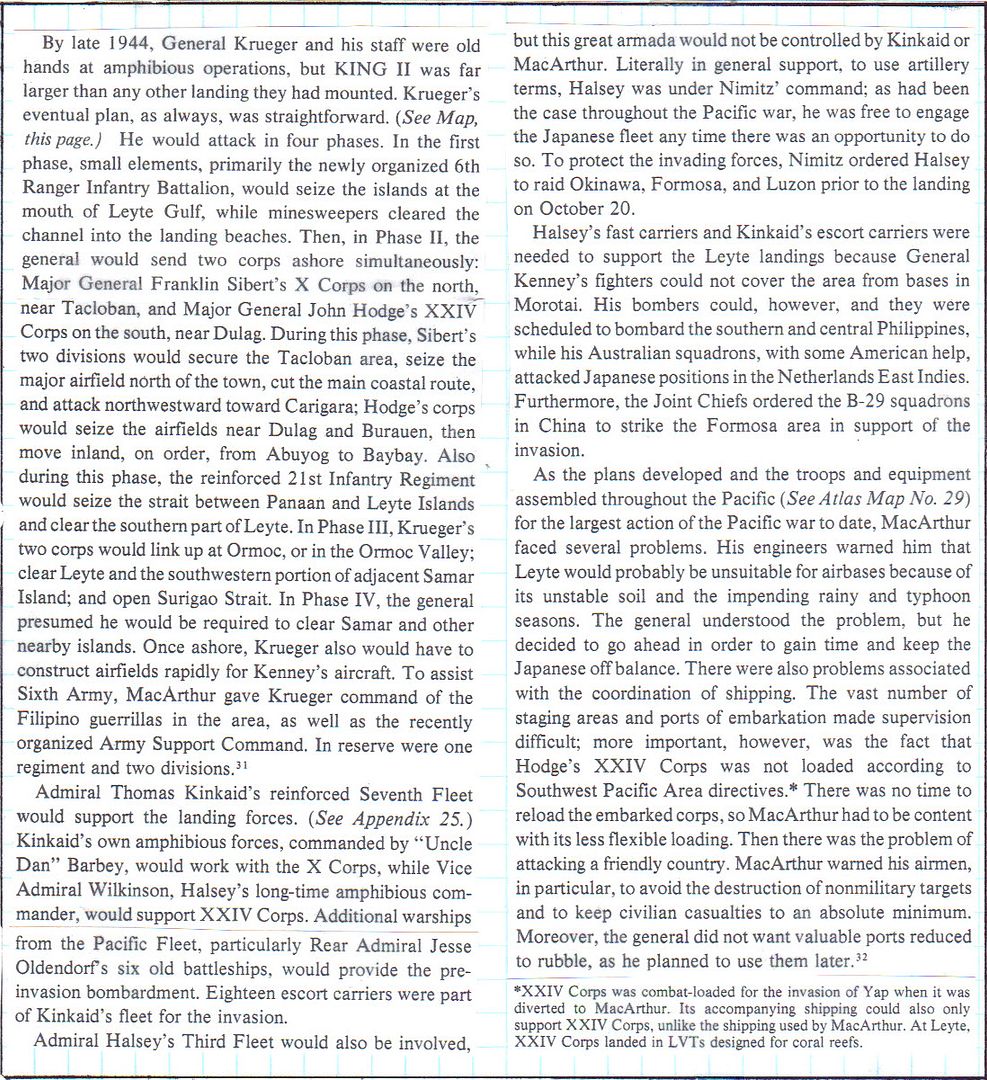
The West Point Military History Series, Thomas E. Griess, Editor, The Second World War: Asia and the Pacific

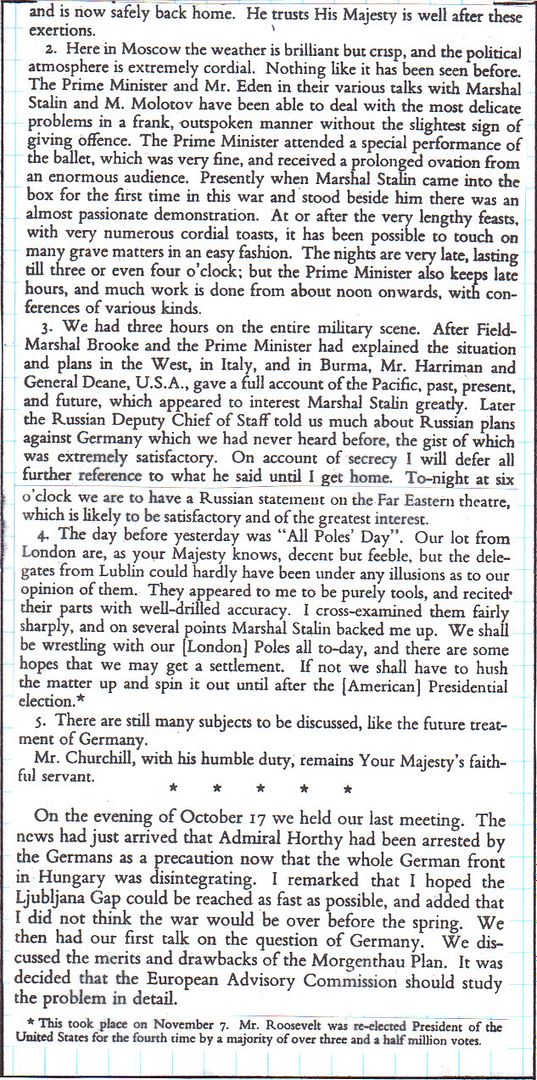
Winston S. Churchill, Triumph and Tragedy
http://www.onwar.com/chrono/1944/oct44/16oct44.htm#
Red Army captures Nis
Monday, October 16, 1944 www.onwar.com
On the Eastern Front... In Yugoslavia, Soviet forces capture Nis after being evacuated by German forces. Bulgarian and Yugoslavian forces are assisting Soviet forces.
In Budapest... There is an announcement that the recent Hungarian request for an armistice is void. Admiral Horthy resigns and is taken to Germany. Ferenc Szalasy becomes regent and prime minister.
On the Western Front... Around Aachen, troops of the US 19th and 8th Corps (elements of US 1st Army) link up to the east of the city, completing its encirclement. Farther south, the US 6th Corps (part of US 7th Army) encounters heavy German resistance around Bruyeres on the Moselle River. To the south, the French 1st Army begins new attacks.
In Greece... British forces land on the island of Lemnos.
In the Philippines... Land-based aircraft of US 13th and 5th Air Forces, from Biak, Sansapor and Morotai, attack targets on Mindanao. US Task Group 77.4 (Admiral TF Sprague), with 18 escort carriers, launches air strikes on Leyte, Cebu and Mindanao.
http://www.etherit.co.uk/month/9/16.htm
October 16th, 1944 (MONDAY)
UNITED KINGDOM: Private Salter of the Pioneer Corps is the first British soldier to be demobilized, and given a regulation “demob suit”.
The US Army Eighth Air Force flies Mission 680: 2 B-17s and 7 B-24s are dispatched on a night leaflet mission to France, the Netherlands and Germany.
All US Army Ninth Air Force operations are cancelled due to bad weather.
U-1006 (Type VIIC41) is sunk southwest of Faroes, at position 60.59N, 04.49W, by depth charges from the Canadian frigate HMCS Annan (K404) A/LCdr. Charles Patrick Balfry, RCNR, CO, and HMCS Loch Achanalt, a Loch-class frigate, LCdr. Richard W. Hart, RCNVR, CO. 6 dead, 44 survivors. Annan gained a sonar contact and attacked with depth charges. The contact was subsequently assessed as a whale and Annan rejoined her escort group. However, in fact it had been U-1006, which was badly damaged and forced to surface. Loch Achanalt subsequently detected U-1006 on radar, whereupon she and Annan were sent back to investigate. U-1006 fired a T-5 acoustic-homing torpedo, which was decoyed by Annan’s CAAT gear and exploded harmlessly. A gun duel ensued during which eight of Annan’s crew were wounded. Annan attacked with depth charges on a shallow setting, which finally sank U-1006. (Alex Gordon)
BELGIUM: British Field Marshal Bernard Montgomery, commander of the 21st Army Group, halts offensive operations except those to speed opening of Antwerp, Belgium, port.
NETHERLANDS: Sgt. George Harold Eardley (b.1912), King’s Shropshire Light Infantry, wiped out three machine-gun posts, allowing the capture of a key position. (Victoria Cross)
The Canadian drive to clear the Netherlandss’ Scheldt river near Antwerp is slowly overcoming German units north and south of the waterway.
In the Canadian First Army’s II Corps area, Zuid Beveland Isthmus is virtually sealed off with the capture of Woensdrecht by the Canadian 2d Division. Canadian The 3d Division continues to reduce the Breskens Pocket south of the Schelde River. The pocket is about half its original size.
In the British Second Army’s VIII Corps area, the 3d Division reaches the outskirts of Venray. Combat Command B, U.S. 7th Armored Division, establishes a bridgehead across the canal on the Deurne-Venray road.
FRANCE: In the U.S. Seventh Army’s VI Corps area, the 45th and 36 Infantry Divisions, against firm opposition, close in on Bruyres, a column from the south pushing through Laval.
In the French First Army’s II Corps area, the 3d Algerian Division and the French1st Armored Division begin an attack to pierce German’s winter line in the Vosges mountain range, pressing toward heights east of the Moselotte River against violent opposition.
During the night of 16/17 October, the USAAF Eighth Air Force flies Mission 680: two B-17 Flying Fortresses and seven B-24 Liberators drop leaflets over the country without loss.
GERMANY: Fighting continues in Aachen while the US XIX and VIII Corps, in the shape of the 1st and 30th Infantry Divisions, link up to the east and complete the encirclement of the city.
The Soviet Army of the Third White Russian Front enters German territory for the first time near Goldap in East Prussia. Thousands of German civilians in the area flee in panic.
This is the Goldap-Gumbinned Operation by General Ivan Chernyiakovsky.
The US VI Corps fights near Bruyeres on the Moselle meeting heavy resistance.
In the U.S. First Army area, the army closes the ring about Aachen as patrols of XIX and VII Corps establish contact on Ravels Hill at 1615 hours. In the XIX Corps area, the 116th Infantry Regiment of the 29th Infantry Division continues to batter Wuerselen, the 30th Infantry Division attacks southward astride the Wurm River with the 119th Infantry Regiment; a patrol makes contact with a patrol of the 18th Infantry Regiment, 1st Infantry Division, VII Corps. In the VII Corps area, the Germans react promptly and vigorously to the closing of Aachen gap, attempting to overrun a roadblock on the Aachen-Wuerselen highway, during the night of 16/17 October. The 16th Infantry Regiment, 1st Infantry Division, stabilizes positions in the Eilendorf area. (John Nicholas and Jack McKillop)
The USAAF Fifteenth Air Force attacks four targets: 32 bomb the Main marshalling yard and 18 hit a railroad bridge at Salzburg and 18 attack the industrial area and a railroad bridge at Liezen.
U-2520 launched.
U-2340, U-3506 commissioned.
USAAF MEDITERRANEAN THEATRE OF OPERATIONS, Nova Scotia.: Maj. George T. Buck, Jr., CO of the 309th FS/31st FG, USAAF, achieves ace status with a score of six confirmed kills when he downs three Bf 109s during withdrawal escort from Brux, Czechoslovakia. (Skip Guidry)
AUSTRIA: Nearly 600 Fifteenth Air Force B-17s and B-24s, with fighter escort, bomb targets in Austria and Czechoslovakia; in Austria, they bomb a tank factory, tank assembly plant, and aero engine works at Steyr, benzol plant and ordnance depot at Linz, plus alternate targets and targets of opportunity, including Graz, the Neudorf aircraft engine factory, Trieben, Linz, Graz, Villach, Salzburg, Klagenfurt, and Sankt Veit an der Glan; in Czechoslovakia, they hit the Brux synthetic oil refinery, and armament works in Plzen. 20+ P-51s and P-38s fly photo and weather reconnaissance missions and sea patrol; 29 P-38s escort Mediterranean Allied Tactical Air Force C-47s (transporting airborne troops) to Greece and back to Italy.
Twelfth Air Force medium bomber operations are cancelled by bad weather; A-20s and fighter-bombers hit troop concentrations, bridges, gun positions, road, rail lines, and vehicles in the battle area, particularly in the Monte Belmonte vicinity.
NORWAY: Junkers Ju-52/3m, msn 640608, registered D-ADQV and named “Hermann Stache” by the German airline Lufthansa, crashes into a mountain in poor weather conditions at Telemark. The 12 passengers and three crew aboard are killed.
FINLAND: Finnish troops reach the ruins of Rovaniemi which had been destroyed by the Germans on 10 October.
HUNGARY: Budapest: The Hungarian government is arrested and sent to Germany.
One USAAF Fifteenth Air Force bomber hits marshalling yard at Hereny.
YUGOSLAVIA: Russian forces capture Nis after the Germans had evacuated. Russian, Bulgarian and Yugoslav units are cooperating in this area.
RAF No. 205 (Heavy Bomber) Group sends 69 bombers to attack the marshalling yard at Zagrab.
ITALY: In the U.S. Fifth Army area, the 6th South African Armoured Division, in conjunction with the II Corps to right, renews their northward attack between the Reno and Setta Rivers. II Corps begins the final phase of attack toward Bologna, making the main effort in center; the left flank is still held up below the Monterumici hill mass. The 34th Infantry Division attacks with two regiments abreast:on the left, the 133d Infantry Regiment drives through the 91st Infantry Division on a narrow front toward Mt. Belmonte, target for artillery and aerial bombardment. Searchlights provide illumination for night action. At this time the use of artificial moonlight is still in the experimental stage. The 85th Infantry Division’s 339th Infantry Regiment attacks toward a ridge above Monterenzio, taking Hill 622. 88th Infantry Division drives toward the Mt. Cuccoli-Mt. Grande ridge on the right flank of corps: the 349th Infantry Regiemnt takes Mt. delle Tombe and reaches St. Clemente.
In the British XIII Corps area, the 78th Division completes relief of U.S. forces on Gesso ridge.
In the British Eighth Army area, the V Corps clears Mt. Romano and Mt. Reale, during the night of 16/17 October. Elements of the 20th Brigade, Indian 10th Divsion, establish a small bridgehead across the Savio River near its confluence with the Borello River on the south flank of the corps. In the Canadian I Corps area, the Canadian 1st Division advances quickly toward Cesena, elements crossing Pisciatello River. Orders are issued for a concerted attack on Cesena by the Canadian I and British V Corps. The New Zealand 2d Division takes Bulgarno without opposition.
USAAF Twelfth Air Force medium bomber operations are cancelled by bad weather while A-20 Havocs and fighter-bombers hit troop concentrations, bridges, gun positions, road, rail lines, and vehicles in the battle area, particularly in the Monte Belmonte vicinity.
Eight USAAF Fifteenth Air Force bombers hit transportation targets of opportunity.
BURMA: 11 Tenth Air Force P-47s attack 2 railroad bridges in the Naba-Mawlu area, damaging approaches to both targets; 5 other P-47s hit Japanese forces in the northwestern part of Madangyang; 12 B-25s, supported by an escort of 8 P-47s, bomb the airfield at Shwebo. Transports fly 300+ sorties in the CBI.
CHINA: The Fourteenth Air Force sends 28 B-24s, 8 B-25s, 26 P-51s, and 21 P-40s to attack shipping and the Kowloon Dock area of Hong Kong; 15 cargo vessels are damaged or sunk; 3 other P-51s hit the Wuchou area; 36 P-40s, P-51s, and P-38s hit village and town areas, bridges, and troop concentrations in the Kweiping, Tanebuk, Hsinganbsien, Tingka, and Chefang areas.
FORMOSA: The XX Bomber Command flies Mission 11. 43 B-29s, out of Chengtu, China, bomb the Okayama aircraft plant aircraft plant and Heito Airfield; 20+ other B-29s bomb alternate or chance targets at Takao, Taichu Airfield and Toshien harbor on Formosa, and Swatow and Sintien harbors, Hengyang, and several airfields in China.
COMMONWEALTH OF THE PHILIPPINES: Preliminary air attacks begin today against Leyte. These preparations for the invasion will continue over the next 3 days.
EAST INDIES: Far East Air Forces P-38s attack the harbor, shipping, airfield and trucks on Cagayan Islands, Philippine Islands. B-24s blast the Makassar area on Celebes Island. B-24s, B-25s, and fighter-bombers again bomb the Boeroe Island-Ceram Island airfields and the towns of Boela on Ceram Island and Amboina on Ambon Island and hit shipping in Binnen Bay in the Moluccas Islands.
NEW GUINEA: In Dutch New Guinea, fighter-bombers hit Timoeka and Mongosah and Sagan Airfields; Langgoer Airfield is pounded by A-20s.
PACIFIC OCEAN: 0600 hours: USS Tilefish (SS-307) sinks a cargo ship at 48-07 N, 153-04E near Matsuwa Jima. Also at 0600 hours: USS Tilefish (SS-307) sinks a picket boat at 48-07 N, 153 04 E. near Matsuwa Jima. (Skip Guidry)
WESTERN PACIFIC: Japanese torpedo planes attack Task Group 30.3 (Rear Admiral Laurance T. DuBose) and again damage light cruiser USS Houston (CL-81).
Japanese reconnaissance pilots tell the Imperial General Staff that the great victory over Task Force 38 two days ago was an illusion. They report that Halsey’s fleet still has 13 carriers, seven battleships and 10 cruisers. It actually has 17 carriers.
In support of the upcoming invasion of Leyte and to cover the damagedUSNships in tow to Ulithi, Task Group 38.4 launches air strikes against Luzon in the Philippines. The aircraft carrier USS Franklin (CV-13) is attacked by three enemy planes, one of which scores with a bomb that hit the after outboard corner of the deck edge elevator, killing 3 and wounding 22.
15 Seventh Air Force P-47s and a B-24 from Saipan attack Pagan Island in the Marianas.
CAROLINE ISLANDS: On Peleliu Island in the Palau Islands, Regimental Combat Team 321 of the 81st Infantry Division, takes responsibility for completing the reduction of the Umurbrogol Pocket and is relieving marines there. Fresh forces, a battalion of the 323d Infantry Regiment, from Ulithi are assisting the 321st Infantry Regiment. At Ngulu Atoll, elements of the 81st Infantry Divsion begins clearing the atoll, which lies between Yap and the Palaus.
Fourteen USAAF Seventh Air Force B-24 Liberators from the Marshall Islands hit Truk Atoll.
GREENLAND: The U.S. Coast Guard icebreaker USCGC Eastwind (WAG-279), supported by sistership USCGC Southwind (WAG-280), captures German weather ship Externsteine off Cape Borgen, Shannon Island, on the east coast of Greenland. Eastwind’s crew unofficially christens the captured auxiliary “Eastbreeze.” Both icebreakers, however, are damaged by pack ice.
CANADA: In Ottawa, Ontario, Lieutenant General Henry Crerar, General Officer Commanding First Canadian Army in the Netherlands, is promoted to the rank of General; he is the first Canadian to hold that rank in the field.
Corvette HMCS Timmins completed forecastle extension refit Sydney, Nova Scotia.
HMC ML 129 commissioned.
U.S.A.: The motion picture “Ministry of Fear” is released today. This film-noir spy drama based on the novel by Graham Greene, is directed by Fritz Lang and stars Ray Milland, Marjorie Reynolds and Dan Duryea. The plot has Milland being released in WWII England after spending two years in a mental institution. On his way to London, he encounters a spy ring and is framed in a complicated espionage plot.
Lloyd C. Douglas’ novel “The Robe” is published today. In 1953, the film of the same name, starring Richard Burton and Jean Simmons, is released. The film is nominated for 5 Academy Awards and wins 2.
Top pop songs in the U.S. today include “I’ll Walk Alone” by Dinah Shore; “Is You Is Or Is You Ain’t (Ma’ Baby)” by Bing Crosby and the Andrews Sisters; “Together” by Dick Haymes And Helen Forrest; and “Smoke on the Water” by Red Foley.
Destroyer escort USS Cecil J Doyle commissioned.
http://ww2db.com/battle_spec.php?battle_id=116
On 13 Oct, “Black Friday”, the Canadian 5th Infantry Brigade’s Black Watch Battalion faced especially tough German counterattack and was nearly wiped out completely. After ten days of fighting, on 16 October 1944 they took Woensdrecht, a town critical in the capture of the isthmus. Two weeks later, a combination of land and amphibious maneuvers attacked German positions at the isthmus. After another week of intense fighting, Canadian troops secured the eastern portion of the isthmus on 24 Oct. South Beveland was secured by the end of the month after the Operation Vitality offensive.
"The secretarial staff of Oskar Schindler's enamelware factory in Kraków assembles for a group photograph.
Intensely loyal to the people who worked for him, Schindler risked his own life to rescue his 300 female workers when they were mistakenly sent on a train to Auschwitz, instead of to safety in Brünnlitz in the Sudetenland, where Schindler had opened his new factory."
Providential answer to prayer here, I think. I can't image why the Germans did not do exactly as Rommel wanted.
I think this argument is portrayed in the movie, "Patton", but instead, the movie showed Rommel arguing with General Alfred Jodl. In the movie, the exchange went something like,
(Jodl): "No, the main landing will be in Calais, where Patton is."
(Rommel, looking disgusted): "You seem perfectly willing to believe this nonsense. Why?"
(Jodl): "Because I am not prepared to dispute the Fuehrer.
Wow. Rommel came close to being on our side in WWII. What a wonderful American tank-commanding general he would have been. He would have also joined the Monty vs. Patton fracas but I've gotta believe he and Patton together probably would have shortened the war.
I joined this thread after this part of things, so I didn't get to see any of the insights and analysis about this. I'd really like to know how Monty did this. Got a link to the best maps and explanation for how a guy like Monty could rout a guy like Rommel?
(Referring to NYT 10/16/44 page 5 “Death of Rommel” + NYT 10/14/44 thread, http://www.freerepublic.com/focus/f-news/3214867/posts post #4):
Somebody should tell Bill O’Reilly to do a book on killing Rommel (I see he’s just come out with a new one, “Killing Patton”).
Dang man, the guy on page 12 NYT looks like Captain America.
The front page notes that the last European ally of Germany has been taken out of the war. The map shows several other European contries still allied with Germany: Austria, Checzovakia, Norway, Italy* and others.
* Still a part of Northern Italy is under German control.
And as PAR35 mentioned yesterday - Japan. Austria and Czechoslovakia might have been considered part of Germany rather than allies. I would call Norway more of an occupied nation than an ally, notwithstanding a number of Norwegians fighting with the Wehrmacht. Were there still any Italian units fighting with the Germans by October '44?
The Nimitz Gray Book references Vice Admiral McCain who was leading Task Group 38.1 But labeled him a Rear Adminral which was corrected to Vice with a handwritten V.
The invasion of Leyte may have been a bigger undertaking than Overlord.
I’ll bet that was Adm. Nimitz (CWN) himself who made the correction.
Disclaimer: Opinions posted on Free Republic are those of the individual posters and do not necessarily represent the opinion of Free Republic or its management. All materials posted herein are protected by copyright law and the exemption for fair use of copyrighted works.